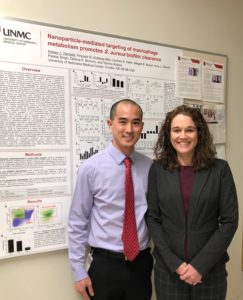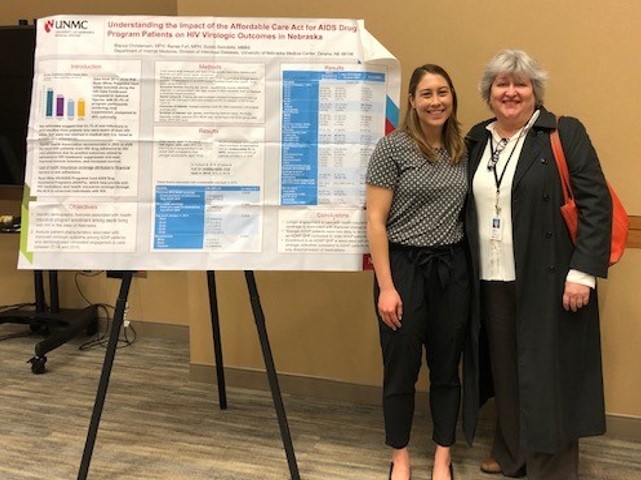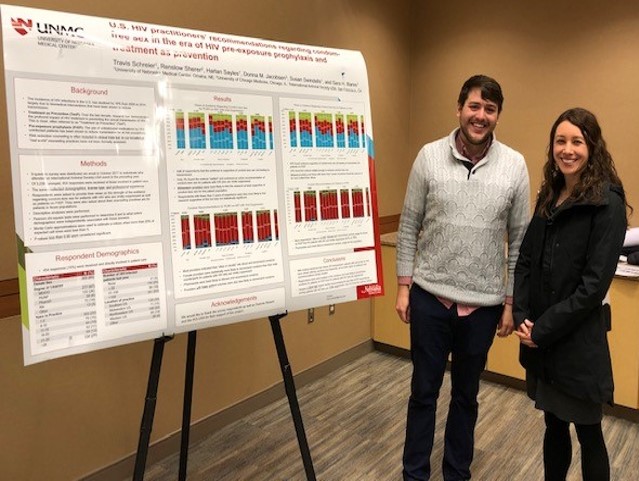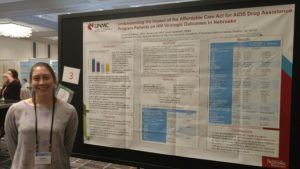 Jonathan (Yoni) Herskovitz is an MD/PhD student working with Dr. Howard Gendelman studying therapies for HIV. We were excited to talk to him about his work and his plans for the future!
Jonathan (Yoni) Herskovitz is an MD/PhD student working with Dr. Howard Gendelman studying therapies for HIV. We were excited to talk to him about his work and his plans for the future!
Tell us a little about yourself and your career goals.
I am California native, and though pursuing a career as a physician-scientist occupies the majority of my time, I still enjoy astronomy and home renovating. After graduating with a BS from UCLA (Go Bruins!), I worked in research at a pharmaceutical company outside Los Angeles for two years. This fostered my love for translational research that I hope to integrate throughout my career. Since I still have my clinical rotations remaining, it’s hard to say what specific field of medicine appeals to me the most, but I am certainly considering fellowship in infectious disease.
Could you tell us a little about your thesis?
My research focuses on optimizing gene therapy for human immunodeficiency virus (HIV). An estimated 36.9 million individuals are infected with HIV worldwide, and unfortunately, require lifelong treatment with antiretroviral drugs. We are developing a targeted delivery scheme for CRISPR-Cas9 (pioneered by our collaborators), that could specifically excise viral DNA from human immune cells. Most importantly, this strategy bears the potential to free patients from chronic reliance on anti-HIV medications.
How do you think your current work will inform your practice of medicine in the future?
 Laboratory research has instilled within me a number of disciplines that I hope to carry with me to clinical practice. I have learned how to formulate and test scientific hypotheses, just as I plan to create differential diagnoses and utilize labs to evaluate possible etiologies for illness. Although HIV infects individual cells, it has the potential to cause damage in almost every major organ system. This notion has taught me that it is important to remember that as clinicians, we treat people, not strictly diseases. Additionally, HIV impacts certain patient populations (e.g. communities in Africa, MSM, and IV drug users) with higher frequencies. It is therefore imperative to seek out opportunities to volunteer in at-risk and medically underserved areas so that I can best understand potential treatment complexities in my regular practice. Finally, my project has taught me to always think about how a particular product or finding can be improved upon. Frequently the answer to these questions requires help from others and it is this dynamic teamwork for the betterment of patients that excites me most about becoming a doctor.
Laboratory research has instilled within me a number of disciplines that I hope to carry with me to clinical practice. I have learned how to formulate and test scientific hypotheses, just as I plan to create differential diagnoses and utilize labs to evaluate possible etiologies for illness. Although HIV infects individual cells, it has the potential to cause damage in almost every major organ system. This notion has taught me that it is important to remember that as clinicians, we treat people, not strictly diseases. Additionally, HIV impacts certain patient populations (e.g. communities in Africa, MSM, and IV drug users) with higher frequencies. It is therefore imperative to seek out opportunities to volunteer in at-risk and medically underserved areas so that I can best understand potential treatment complexities in my regular practice. Finally, my project has taught me to always think about how a particular product or finding can be improved upon. Frequently the answer to these questions requires help from others and it is this dynamic teamwork for the betterment of patients that excites me most about becoming a doctor.
Tell us something about yourself unrelated to medicine and your research.
 I am an avid amateur stargazer / space enthusiast. Looking at our universe through my telescope and learning about various technologies to explore it inspires me too look past my immediate concerns towards something greater. Plus, my wife usually joins me for these astronomy outings, which is always a bonus.
I am an avid amateur stargazer / space enthusiast. Looking at our universe through my telescope and learning about various technologies to explore it inspires me too look past my immediate concerns towards something greater. Plus, my wife usually joins me for these astronomy outings, which is always a bonus.
We’re proud to have people like Yoni at UNMC who are furthering our understanding of complicated diseases and helping us provide the best care. If you’re interested in learning more about his work, check out his publications below:
Kinderman F, Yerby B, Jawa V, Joubert MK, Joh NH, Malella J, Herskovitz J, Xie , Ferba J, McBride H. Impact of Precipitation of Antibody Therapeutics following Subcutaneous Injection on Pharmacokinetics and Immunogenicity. J Pharm Sci. doi: 10.1016/j.xphs.2019.01.015 (2019).
Herskovitz J, & Gendelman, HE. HIV and the macrophage: from cell reservoirs to drug delivery to viral eradication. J Neuroimmune Pharmacology. doi: 10.1007/s11481-018-9785-6 (2018).
Herskovitz J, Ryman J, Thway T, Lee S, Zhou L, Chirmule N, Meibohm B, & Jawa V. Immune Suppression During Preclinical Drug Development Mitigates Immunogenicity-Mediated Impact on Therapeutic Exposure. J AAPS 19, 447-455, doi:10.1208/s12248-016-0026-8 (2017).
Joubert MK, Deshpande M, Yang J, Reynolds H, Bryson C, Fogg M, Baker MP, Herskovitz J, Goletz TJ, Zhou L, Moxness M, Flynn GC, Narhi LO, & Jawa V. Use of In Vitro Assays to Assess Immunogenicity Risk of Antibody-Based Biotherapeutics. PLoS One 11, e0159328, doi:10.1371/journal.pone.0159328 (2016).
Pandey P, Sliker B, Peters HL, Tuli A, Herskovitz J, Smits K, Purohit A, Singh RK, Dong J, Batra SK, Coulter DW, & Solheim, J. C. Amyloid precursor protein and amyloid precursor-like protein 2 in cancer. Oncotarget 7, 19430-19444, doi:10.18632/oncotarget.7103 (2016).
Cunningham CR, Champhekar A, Tullius MV, Dillon BJ, Zhen A, de la Fuente JR, Herskovitz J, Elsaesser H, Snell LM, Wilson EB, de la Torre JC, Kitchen SG, Horwitz MA, Bensinger SJ, Smale ST, & Brooks DG. Type I and Type II Interferon Coordinately Regulate Suppressive Dendritic Cell Fate and Function during Viral Persistence. PLoS Pathog 12, e1005356, doi:10.1371/journal.ppat.1005356 (2016).
Wilson EB1, Yamada DH, Elsaesser H, Herskovitz J, Deng J, Cheng G, Aronow BJ, Karp CL, Brooks DG. Blockade of chronic type I interferon signaling to control persistent LCMV infection. Science. 340(6129):202-7. doi: 10.1126/science.1235208.
 Dr. Sara Bares
Dr. Sara Bares  Dr. Jasmine Marcelin
Dr. Jasmine Marcelin Dr. Trevor Van Schooneveld
Dr. Trevor Van Schooneveld
 As Dr. Cawcutt wrote in her review, “De-escalation in culture-negative pneumonia may result in lower AKI and ICU and hospital LOS. There is clear potential benefit for patients and overall health care systems in advocating for earlier de-escalation, regardless of whether or not nares swabs were completed.”
As Dr. Cawcutt wrote in her review, “De-escalation in culture-negative pneumonia may result in lower AKI and ICU and hospital LOS. There is clear potential benefit for patients and overall health care systems in advocating for earlier de-escalation, regardless of whether or not nares swabs were completed.”
 My thesis research focused on trying to understand how orthopedic implant associated S. aureus biofilms modulates the metabolism of monocytes in order to promote the establishment and persistence of infection. Though my current research is on a fairly specific ailment, it may not directly inform my clinical practice in the future (unless of course I go into orthopedics). However, I have had a lot of opportunities to work on both the clinical and basic science side of a clinical study on orthopedic implant infections. It has helped me to understand how important communication is when trying to develop and carry out a clinical study. In my future, it will be essential for me to bridge the gap between the clinical and research teams.
My thesis research focused on trying to understand how orthopedic implant associated S. aureus biofilms modulates the metabolism of monocytes in order to promote the establishment and persistence of infection. Though my current research is on a fairly specific ailment, it may not directly inform my clinical practice in the future (unless of course I go into orthopedics). However, I have had a lot of opportunities to work on both the clinical and basic science side of a clinical study on orthopedic implant infections. It has helped me to understand how important communication is when trying to develop and carry out a clinical study. In my future, it will be essential for me to bridge the gap between the clinical and research teams.  Jonathan (Yoni) Herskovitz is an MD/PhD student working with Dr. Howard Gendelman studying therapies for HIV. We were excited to talk to him about his work and his plans for the future!
Jonathan (Yoni) Herskovitz is an MD/PhD student working with Dr. Howard Gendelman studying therapies for HIV. We were excited to talk to him about his work and his plans for the future! Laboratory research has instilled within me a number of disciplines that I hope to carry with me to clinical practice. I have learned how to formulate and test scientific hypotheses, just as I plan to create differential diagnoses and utilize labs to evaluate possible etiologies for illness. Although HIV infects individual cells, it has the potential to cause damage in almost every major organ system. This notion has taught me that it is important to remember that as clinicians, we treat people, not strictly diseases. Additionally, HIV impacts certain patient populations (e.g. communities in Africa, MSM, and IV drug users) with higher frequencies. It is therefore imperative to seek out opportunities to volunteer in at-risk and medically underserved areas so that I can best understand potential treatment complexities in my regular practice. Finally, my project has taught me to always think about how a particular product or finding can be improved upon. Frequently the answer to these questions requires help from others and it is this dynamic teamwork for the betterment of patients that excites me most about becoming a doctor.
Laboratory research has instilled within me a number of disciplines that I hope to carry with me to clinical practice. I have learned how to formulate and test scientific hypotheses, just as I plan to create differential diagnoses and utilize labs to evaluate possible etiologies for illness. Although HIV infects individual cells, it has the potential to cause damage in almost every major organ system. This notion has taught me that it is important to remember that as clinicians, we treat people, not strictly diseases. Additionally, HIV impacts certain patient populations (e.g. communities in Africa, MSM, and IV drug users) with higher frequencies. It is therefore imperative to seek out opportunities to volunteer in at-risk and medically underserved areas so that I can best understand potential treatment complexities in my regular practice. Finally, my project has taught me to always think about how a particular product or finding can be improved upon. Frequently the answer to these questions requires help from others and it is this dynamic teamwork for the betterment of patients that excites me most about becoming a doctor. I am an avid amateur stargazer / space enthusiast. Looking at our universe through my telescope and learning about various technologies to explore it inspires me too look past my immediate concerns towards something greater. Plus, my wife usually joins me for these astronomy outings, which is always a bonus.
I am an avid amateur stargazer / space enthusiast. Looking at our universe through my telescope and learning about various technologies to explore it inspires me too look past my immediate concerns towards something greater. Plus, my wife usually joins me for these astronomy outings, which is always a bonus.
 Bianca’s project is a retrospective cohort study identifying the demographic features and virologic outcomes associated with health insurance enrollment among AIDS Drug Assistance (ADAP) participants in Nebraska. The study found that ADAP users who received insurance in addition to ART supply were more likely to achieve virological suppression than those who only received ART supply. She presented her capstone project at the the American Conference for the Treatment of HIV in Chicago in April 2018, and will be submitting her work for publication. You can read more information about Bianca
Bianca’s project is a retrospective cohort study identifying the demographic features and virologic outcomes associated with health insurance enrollment among AIDS Drug Assistance (ADAP) participants in Nebraska. The study found that ADAP users who received insurance in addition to ART supply were more likely to achieve virological suppression than those who only received ART supply. She presented her capstone project at the the American Conference for the Treatment of HIV in Chicago in April 2018, and will be submitting her work for publication. You can read more information about Bianca  Travis’ project looked at characterizing HIV practitioners’ recommendations regarding treatment as prevention, pre-exposure prophylaxis and condom use. The study found that most practitioners commonly or always recommend condoms despite the fact that most acknowledge the validity of data that successful treatment of HIV or use PrEP prevents transmission. Travis was the first author on the resulting paper entitled: “U.S. HIV practitioners’ recommendations regarding condom-free sex in the era of HIV pre-exposure prophylaxis and treatment as prevention“, published in
Travis’ project looked at characterizing HIV practitioners’ recommendations regarding treatment as prevention, pre-exposure prophylaxis and condom use. The study found that most practitioners commonly or always recommend condoms despite the fact that most acknowledge the validity of data that successful treatment of HIV or use PrEP prevents transmission. Travis was the first author on the resulting paper entitled: “U.S. HIV practitioners’ recommendations regarding condom-free sex in the era of HIV pre-exposure prophylaxis and treatment as prevention“, published in  Congratulations again to Bianca and Travis, we are proud of you! And congratulations to all M4s out there who found out where they matched today!
Congratulations again to Bianca and Travis, we are proud of you! And congratulations to all M4s out there who found out where they matched today! Our department is proud to participate in UNMC College of Medicine’s Enhanced Medical Education Track (EMET) program! EMETs are enrichment opportunities to explore interdisciplinary fields of medicine with in small groups and with close faculty mentorship. Two students from each medical school class are selected to participate in our Comprehensive HIV Medicine EMET, a program that spans their four years in medical school and includes journal clubs, seminars, and clinical experiences culminating in a capstone project focused on an aspect of HIV care. Today we’re excited to feature Bianca Christensen, an M4 completing her EMET experience!
Our department is proud to participate in UNMC College of Medicine’s Enhanced Medical Education Track (EMET) program! EMETs are enrichment opportunities to explore interdisciplinary fields of medicine with in small groups and with close faculty mentorship. Two students from each medical school class are selected to participate in our Comprehensive HIV Medicine EMET, a program that spans their four years in medical school and includes journal clubs, seminars, and clinical experiences culminating in a capstone project focused on an aspect of HIV care. Today we’re excited to feature Bianca Christensen, an M4 completing her EMET experience!
Recent Comments